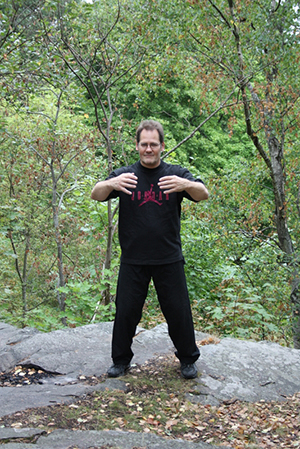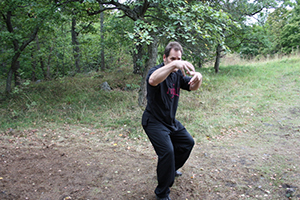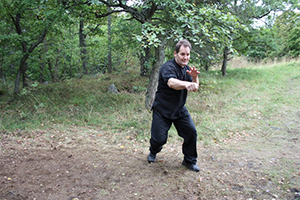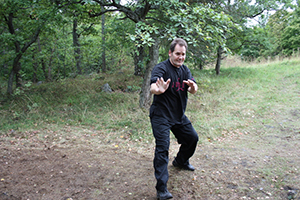
| My journey with Yoshinken | 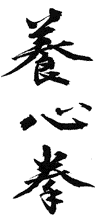 Yoshinken |
||||
Sensei Monika
I've had experience with multiple Budo disciplines prior to Yoshinken. In 1976 I started practicing Ju jutsu with Sensei Björn Hornwall as well as Wado Ryu with Sensei Ray Young. Two disciplines that complemented each other well. Later on I was introduced to Sensei Takashi Masuyama, Okinawa Goju Ryu. He promoted the classic style of karate where the spirits of Budo were highlighted. That suited me and I trained with him for about five years. During this period I had the honor of meeting and training with Sensei Higaonna on Okinawa and in Scotland. A truly grand Sensei. Both Sensei Marshall and Sensei Michael Söderqvist happened to be on Okinawa at this time and little did I know that 24 years later I would be training with Sensei Marshall. A cold day in January 2005 I arrived to a snowy Dojo in the Haga Park but was greeted with only warmth by Sensei Åke, the group and finally Sensei Marshall. Unfamiliar to me was the concept of principles rather than techniques. I also got to experience independent guidance which gave everyone opportunity to evolve regardless of previous Budo/Wushu backgrounds, age or gender. One of my fondest memories were the five summer Gasshuku in Lygnared. To be able to meet and train with practitioners and Senseis from both Holland (Sensei Kallenbach, Wiert, Bakker and Bert) and France (Sensei Legree and Leseur) is something I will cherish forevermore. The internal training, Nei Jia, has been a difficult study but pays off in the long run both in combat and well-being. During difficult times, whether physical or mental, the wisdom given to me through Yoshinken has helped me immensely. We have now entered a higher form of Yoshinken. Sensei Marshall depicts the training development as a spiral where the new is a continuation of the old. I believe my Budo/Wushu expertise has been broadened, and especially deepened, during my years with Yoshinken. Which, in part, is the point of Yoshinken. Alongside increased vitality and well-being. This is what the Qi practice gives me. As the only female in the group, small and not so young any more, I've faced several challenges. But, I'm still hanging on! I want to thank Sensei Marshall, Sensei Åke and all my companions from the group for the guidance and inspiration on my "never-ending journey".
Osu Monika
|
Sensei Anders
Yoshinken is celebrating its 20th anniversary this year, so I have been asked to write a few lines about my history within Budo and Yoshinken. My name is Anders Bengtsson and I have trained Budo for 47 years, time goes by without you having time to think about it, I have trained Ju-Jutsu, Judo, Karate, Aikido, a little Iai Do etc. for 37 years, the last 22 years have I trained Tai Ki Ken combined with Ju-Jutsu for about 10 years, so I have some experience in Budo. For the last 12 years I have concentrated on only training Yoshinken, which is a style of Tai Ki Ken developed by my Sensei Kyoshi Marshall McDonagh. Some information about the origin of the style. Yo = Bring forth, support, cultivate. Shin = "Spirit" Feeling of a new meaning and future. Ken = Sword, clenched fist, "ken" as in Taikiken. Yoshinken was founded and established in Sweden in the summer of 2002 by Marshall McDonagh, this based on his background and experience in Japanese Budo and Chinese Wushu, especially in Taikiken (Japan) and Yiquan (China). I started training Ju-Jutsu in 1975 in Budokwai Dojo forSempai Jan Linderholm, then it was Sensei Björn Hornwall 4 dan who took care of my training to become a good Ju-Jutsuka, Björn became my first Sensei. A real Sensei who became a role model for me and a really good friend whom I miss a lot as he passed away from illness far too soon. I continued my training without Sensei's with some success, instructing for 34 years in Budokwai Dojo and Solna Ju-Jutsu club. Other Sensei's that I have trained with is Magnus Cederblad 8 Dan who was also my grading partner to 2 dan and 3 dan as well as to 4 dan, tough and good gradings were made, these gradings are imprinted in my memory forever. My instructor in Wado Ryu Karate was Sensei Ray Young 7 Dan with several other great instructors such as Tatsuo Suzuki 8 Dan with several great practitioners of World Class, none mentioned, none forgotten. Karate was included as an important complement to Ju-Jutsun, likewise Judon, also Aikido (tai sabaki) was important to become a good Ju-Jutsuka, a small summary up to where I am now, Yoshinken. In 1999 I started training Tai Ki Ken for Sensei Marshall McDonagh, I remember it like yesterday except for what date, we were a number of practitioners who were invited to participate, mostly from Oyama Karate Kai and me from Solna Ju-Jutsu, we started training with a introduction about what Tai Ki Ken came from, then it was time for Ritsu Zen for the first time, and it was a new experience that later became very important. I remember the wonder of my students, after I trained for a few years, have you gained weight? You feel so heavy and hard to move, what has happened? My answer Ritsu Zen. Of course, I got questions about Tai Ki Ken from my students, but considering that I had just become familiar with the art, the answers to the questions had to wait. The hardest thing for me was standing in Ritsu Zen/Han Zen without feeling pain and discomfort, but after a couple of months it started to feel much better, when it worked at its best you got a feeling of joy and balance in the body, obviously so it worked fairly well at the beginning, but standing for 45-60 minutes was not something you looked forward to at the beginning, probably the hardest thing I've done in my Budoliv, but after a couple of years of training it felt much better, so it's just to keep developing as best you can in Yoshinken, after 22 years you are still a beginner. But there is hope to develop in Ritsu Zen, Han Zen, Yuri, Neri, Hai, Mukae-te, Harai-te , Sashi-te, Sui shu as well as Tanshu and Kumite, so there is plenty to do going forward, what is difficult must be done as easily as possible and it is not always that easy. But having a "real" Bodo Sensei like Kyoshi Marshall McDonagh, who help me and my training companions' development within the Yoshinken, belonging to the Neijaquan or the i internal martial arts system. You must use your whole body with feeling and balance, the whole body must function as a complete unit for maximum effect. Then we have another clear advantage within Yoshinken and that is the health part, the blood pressure is better controlled, problems are easier to process, the arthritis gets better with Yuri, many points are precise with what physiotherapists teach, you simply feel better the more you practice and get into the nature. I myself have found it easier to take care of the problems that almost all people have or will be faced with when facing when you get older, both mental and physical, this is very positive in my opinion. Another thing that has also been positive and rewarding for me is meeting a lot of interesting practitioners in Tai Ki Ken and Yoshinken and very knowledgeable and interesting Sensei's such as Kyoshi Marshall McDonagh and Kyoshi Jan Kallenbach, Sensei Jacques Legree, Sensei Bert De Waart, Sensei Weirt Postema, Sensei Hans Bakker and many more, and to train with their talented students. Another interesting effect of the Yoshinken training is that you become calmer and gain a self-confidence that makes you feel good. So I can really recommend others with a Budo background to try Yoshinken. Looking forward to my future adventures with Yoshinken and my training buddies as travel buddies, hopefully Keiko with our friends in Europe, that would be a lot of fun, but we'll have to work this out.
Osu Anders Bengtsson 3 Dan Mokuroku Yoshinken, 4 Dan Ju-Jutsu, 2 kyu Judo, 7 Kyu Karate Wado Ryu
|
||||
|
|||||
